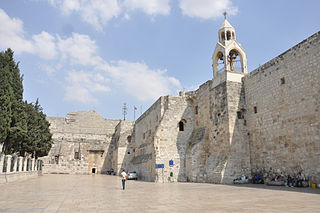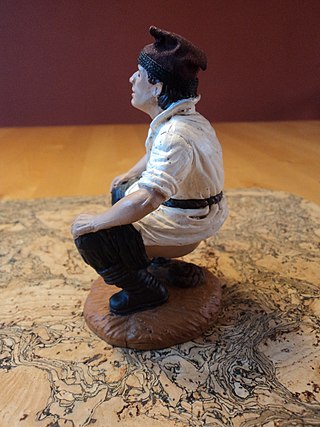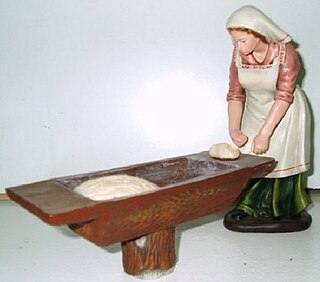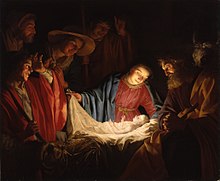
The Church of the Nativity, or Basilica of the Nativity, is a basilica located in Bethlehem in West Bank Palestinian territories. The grotto it contains holds a prominent religious significance to Christians of various denominations as the birthplace of Jesus. The grotto is the oldest site continuously used as a place of worship in Christianity, and the basilica is the oldest major church in the Holy Land.

Christmas Eve is the evening or entire day before Christmas Day, the festival commemorating the birth of Jesus. Christmas Day is observed around the world, and Christmas Eve is widely observed as a full or partial holiday in anticipation of Christmas Day. Together, both days are considered one of the most culturally significant celebrations in Christendom and Western society.

In the Christian tradition, a nativity scene is the special exhibition, particularly during the Christmas season, of art objects representing the birth of Jesus. While the term "nativity scene" may be used of any representation of the very common subject of the Nativity of Jesus in art, it has a more specialized sense referring to seasonal displays, either using model figures in a setting or reenactments called "living nativity scenes" in which real humans and animals participate. Nativity scenes exhibit figures representing the infant Jesus, his mother, Mary, and her husband, Joseph.

The nativity of Jesus, nativity of Christ, birth of Jesus or birth of Christ is described in the biblical gospels of Luke and Matthew. The two accounts agree that Jesus was born in Bethlehem in Judaea, his mother Mary was engaged to a man named Joseph, who was descended from King David and was not his biological father, and that his birth was caused by divine intervention. Many modern scholars consider the birth narratives unhistorical because they are laced with theology and present two different accounts which cannot be harmonised into a single coherent narrative. But many others view the discussion of historicity as secondary, given that gospels were primarily written as theological documents rather than chronological timelines.

Filter feeders are a sub-group of suspension feeding animals that feed by straining suspended matter and food particles from water, typically by passing the water over a specialized filtering structure. Some animals that use this method of feeding are clams, krill, sponges, baleen whales, and many fish. Some birds, such as flamingos and certain species of duck, are also filter feeders. Filter feeders can play an important role in clarifying water, and are therefore considered ecosystem engineers. They are also important in bioaccumulation and, as a result, as indicator organisms.

Epiphany, also known as "Theophany" in Eastern Christian tradition, is a Christian feast day commemorating the visit of the Magi, the baptism of Jesus, and the wedding at Cana.

A Caganer is a figurine depicted in the act of defecation appearing in nativity scenes in Catalonia and neighbouring areas with Catalan culture such as Andorra, Valencia, Balearic Islands, and Northern Catalonia. It is most popular and widespread in these areas, but can also be found in other areas of Spain (Murcia), Portugal, and southern Italy (Naples).

A barnyard or farmyard is an enclosed or open yard adjoining a barn, and, typically, related farm buildings, including a farmhouse. Enclosed barnyards are usually formed by a combination of fences and farm structures.

Kūčios or Kūtės is the traditional Christmas Eve dinner in Lithuania, held on December 24. The meal is a family occasion which includes many traditions of both pagan and Christian origin. Some traditions are no longer widespread and usually Lithuanians just enjoy dinner with relatives and friends while the main events and festivities are left for Christmas Day.

The Nativity of Jesus has been a major subject of Christian art since the 4th century.

The annunciation to the shepherds is an episode in the Nativity of Jesus described in the Bible in Luke 2, in which angels tell a group of shepherds about the birth of Jesus. It is a common subject of Christian art and of Christmas carols.
Baby Jesus theft is the theft of figurines of the infant Jesus from outdoor public and private nativity displays during the Christmas season. It is an "enduring practice" according to New York Times journalist Katie Rogers, "believed to be part of a yearly tradition, often carried out by bored teenagers looking for an easy prank." Sometimes these are stolen for resale, other times the associated pranks are more involved and include dropping it off somewhere else.

The Northern Palace, also called the North Palace, is located in the abandoned Northern Suburbs of the city of Ahketaten. This palace should not be confused with the North Riverside Palace further north in Amarna.

Poultry feed is food for farm poultry, including chickens, ducks, geese and other domestic birds.

Christmas in Mexico is observed from December 12 to January 6, with one additional celebration on February 2. Traditional decorations displayed on this holiday include nativity scenes, poinsettias, and Christmas trees. The season begins with celebrations related to the Virgin of Guadalupe, the Patroness of Mexico, followed by traditions such as Las Posadas and Pastorelas.

A bread trough, dough trough or kneading trough, sometimes referred to as artesa, is a rectangular receptacle with a shallow basin, and a traditional kneading tool used for the making of dough. The wooden form has been used in Europe for centuries in breadmaking.

The Devil's Farmhouse, also known in Maltese as Ir-Razzett tax-Xitan, and officially as Ir-Razzett Tax-Xjaten, is an 18th-century farmhouse in Mellieħa, Malta. The farmhouse features two unconnected buildings. The original scope for the buildings were to function as stables and a horse-riding school (Cavalerizza).




















